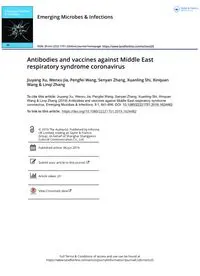
2019 Antibodies and vaccines against Middle East respiratory syndrome coronavirus PDF
Preview 2019 Antibodies and vaccines against Middle East respiratory syndrome coronavirus
Full Terms & Conditions of access and use can be found at https://www.tandfonline.com/action/journalInformation?journalCode=temi20 Emerging Microbes & Infections ISSN: (Print) 2222-1751 (Online) Journal homepage: https://www.tandfonline.com/loi/temi20 Antibodies and vaccines against Middle East respiratory syndrome coronavirus Jiuyang Xu, Wenxu Jia, Pengfei Wang, Senyan Zhang, Xuanling Shi, Xinquan Wang & Linqi Zhang To cite this article: Jiuyang Xu, Wenxu Jia, Pengfei Wang, Senyan Zhang, Xuanling Shi, Xinquan Wang & Linqi Zhang (2019) Antibodies and vaccines against Middle East respiratory syndrome coronavirus, Emerging Microbes & Infections, 8:1, 841-856, DOI: 10.1080/22221751.2019.1624482 To link to this article: https://doi.org/10.1080/22221751.2019.1624482 © 2019 The Author(s). Published by Informa UK Limited, trading as Taylor & Francis Group, on behalf of Shanghai Shangyixun Cultural Communication Co., Ltd Published online: 06 Jun 2019. Submit your article to this journal Article views: 23 View Crossmark data Antibodies and vaccines against Middle East respiratory syndrome coronavirus Jiuyang Xu a, Wenxu Jiaa, Pengfei Wangb, Senyan Zhangb, Xuanling Shia, Xinquan Wang b and Linqi Zhang a aComprehensive AIDS Research Center, Collaborative Innovation Center for Diagnosis and Treatment of Infectious Diseases, Beijing Advanced Innovation Center for Structural Biology, Department of Basic Medical Sciences, Tsinghua University School of Medicine, Beijing, People’s Republic of China; bMinistry of Education Key Laboratory of Protein Science, Beijing Advanced Innovation Center for Structural Biology, Collaborative Innovation Center for Biotherapy, Tsinghua University School of Life Sciences, Beijing, People’s Republic of China ABSTRACT The Middle East respiratory syndrome coronavirus (MERS-CoV) has spread through 27 countries and infected more than 2,200 people since its first outbreak in Saudi Arabia in 2012. The high fatality rate (35.4%) of this novel coronavirus and its persistent wide spread infectiousness in animal reservoirs have generated tremendous global public health concern. However, no licensed therapeutic agents or vaccines against MERS-CoV are currently available and only a limited few have entered clinical trials. Among all the potential targets of MERS-CoV, the spike glycoprotein (S) has been the most well-studied due to its critical role in mediating viral entry and in inducing a protective antibody response in infected individuals. The most notable studies include the recent discoveries of monoclonal antibodies and development of candidate vaccines against the S glycoprotein. Structural characterization of MERS-CoV S protein bound with these monoclonal antibodies has provided insights into the mechanisms of humoral immune responses against MERS-CoV infection. The current review aims to highlight these developments and discuss possible hurdles and strategies to translate these discoveries into ultimate medical interventions against MERS-CoV infection. ARTICLE HISTORY Received 26 March 2019; Revised 10 May 2019; Accepted 13 May 2019 KEYWORDS Coronavirus; MERS-CoV; spike glycoprotein; monoclonal antibody; vaccine 1. Introduction The rapid emergence and dissemination of infectious diseases has taken a heavy toll on humans since the beginning of the twenty-first century. One of the most well-known examples was the outbreak of severe acute respiratory syndrome (SARS) in the winter of 2002 and 2003, caused by a novel coronavirus (SARS-CoV) [1,2]. In distinct contrast to the mild human coronaviruses HCoV-229E [3], HCoV-OC43 [4], HCoV-NL63 [5], and HCoV-HKU1 [6], infection with SARS-CoV frequently resulted in severe symp- toms including fever, dry cough, shortness of breath and pneumonia. Transmission of SARS-CoV was pri- marily from person to person and most cases occurred in health care settings lacking adequate infection con- trol precautions [2]. The SARS outbreak had severe consequences in 29 countries and regions, infecting 8096 people worldwide with a fatality rate of approxi- mately 10% [7]. There are still no vaccines or thera- peutics specific to SARS-CoV available 16 years after the SARS outbreak. It is not hard to imagine how cat- astrophic it would be if SARS-CoV were to hit the human community again. While SARS-CoV remains a mystery and a loose cannon, another novel coronavirus emerged in Saudi Arabia in 2012, later known as the Middle East respir- atory syndrome coronavirus (MERS-CoV) [8]. The fatality rate of MERS-CoV infection is approximately © 2019 The Author(s). Published by Informa UK Limited, trading as Taylor & Francis Group, on behalf of Shanghai Shangyixun Cultural Communication Co., Ltd This is an Open Access article distributed under the terms of the Creative Commons Attribution License (http://creativecommons.org/licenses/by/4.0/), which permits unrestricted use, distribution, and reproduction in any medium, provided the original work is properly cited. CONTACT Xinquan Wang
